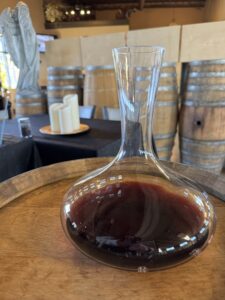Decanting has long been viewed as an essential step to enhance the drinking experience. But what exactly is decanting, and why has it remained a staple in the art of wine appreciation? In this blog, let’s explore the history of decanting, its purpose, and tips for doing it effectively.
A Brief History of Decanting
The practice of decanting dates back centuries, with roots in ancient civilizations. The Romans and Greeks would often pour wine from clay amphorae into goblets to separate it from sediment.
In the 18th century, the tradition solidified in Europe, especially among the aristocracy, who saw decanting as a mark of sophistication. It became common for fine wines, particularly reds, to be decanted before serving, often involving elaborate glass decanters that showcased the wine’s colour and clarity.
Why Decant?
Decanting serves several important purposes:
1. Sediment Separation
Many wines, particularly older reds, can develop sediment over time. Decanting allows the wine to be poured into a new vessel while leaving the sediment behind, preventing a gritty texture in your glass.
2. Aeration
Pouring wine into a decanter exposes it to air, which can enhance its aroma and flavour profile. This process helps volatile compounds evaporate, softening tannins and allowing the wine to breathe, resulting in a more enjoyable tasting experience.
3. Temperature Regulation
Decanting can also help bring the wine to its optimal serving temperature. Wine that has been stored in a cool cellar may benefit from a little time in a decanter at room temperature before being served.
How to Decant
Decanting is more than just pouring wine into a different vessel; it’s an art form! Here’s how to do it properly:
1. Choose the Right Decanter
Just as choosing the right glass enhances your wine experience, selecting the appropriate decanter is equally important. The type of decanter should complement the specific wine you’re serving to fully unlock its flavours and aromas. For older wines, a decanter with a wide base is ideal to maximize aeration. For younger wines, a narrower decanter may suffice.

2. Pour Carefully
When pouring, do so slowly and gently to minimize disturbance. Tilt the bottle slightly, and aim for the center of the decanter, allowing the wine to flow down the sides. Once you reach the bottom of the bottle, pour even more slowly and stop pouring when you see sediment reach the neck of the wine bottle.
3. Let it Breathe
After decanting, allow the wine to sit for a while. Young wines may benefit from 30 minutes to an hour to up to several hours, while older wines typically require around 15 to 30 minutes.
Decanting plays a crucial role in enhancing the flavours and aromas of wine. Understanding its history and purpose can deepen your appreciation for this practice, whether you’re enjoying a special bottle or simply elevating your everyday wine experience.

